Table of Contents
Overview of Klaviyo and Omnisend
When it comes to email marketing for e-commerce businesses, two popular platforms that often come up in discussions are Klaviyo and Omnisend. Both tools are known for their robust automation capabilities, powerful integrations, and user-friendly interfaces. However, they cater to slightly different user needs and offer distinct features. In this section, we’ll provide an overview of Klaviyo and Omnisend, helping you better understand what each platform has to offer.
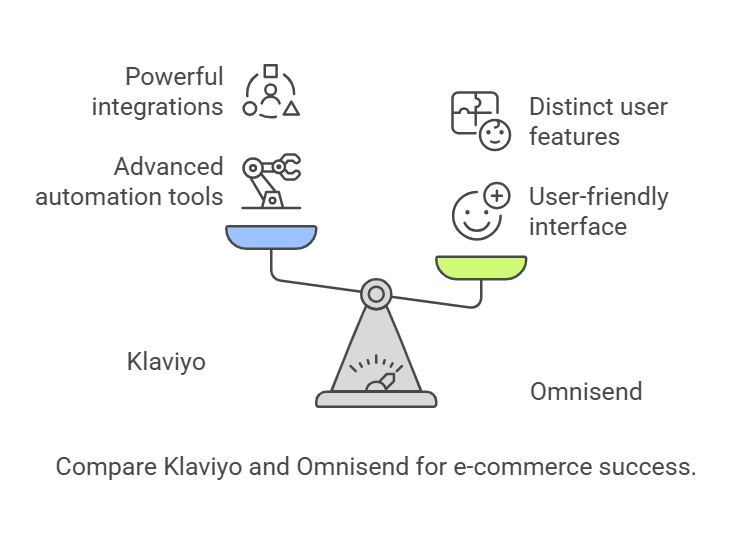
Klaviyo is an advanced email marketing platform that’s especially well-suited for e-commerce businesses looking for powerful automation and segmentation. Founded in 2012, it has gained popularity for its in-depth analytics, seamless integrations with e-commerce platforms (such as Shopify, BigCommerce, and WooCommerce), and sophisticated segmentation capabilities. With Klaviyo, businesses can create highly personalized email campaigns based on user behavior, which leads to better engagement and higher conversion rates.

Omnisend, on the other hand, is a versatile email and SMS marketing platform designed for e-commerce businesses of all sizes. Founded in 2014, Omnisend is known for its all-in-one approach to marketing automation, which includes email marketing, SMS campaigns, and even push notifications. It offers many of the same features as Klaviyo, such as advanced automation and segmentation, but with a focus on multi-channel communication. Omnisend also prides itself on its affordability, making it an attractive option for businesses on a tighter budget.
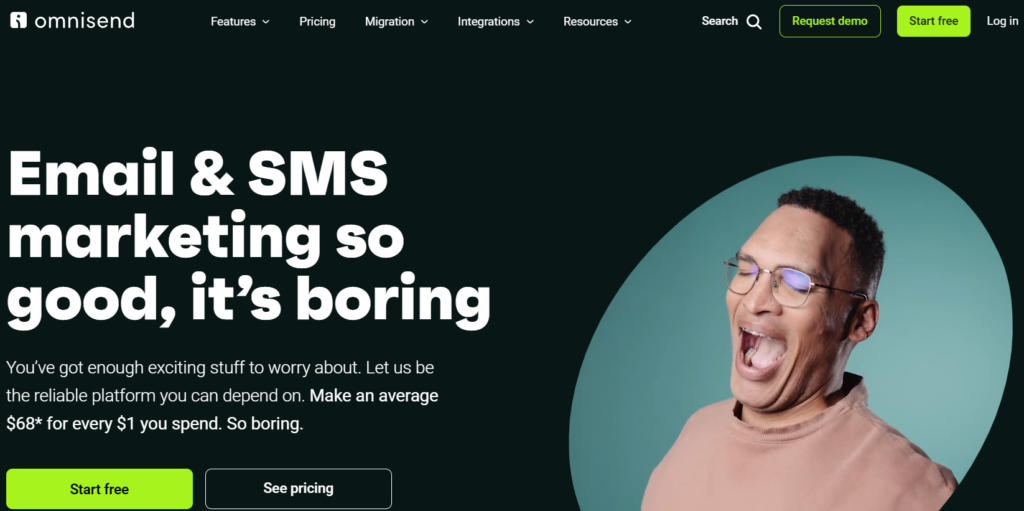
When to Choose Klaviyo vs Omnisend?
- If your business is focused on email marketing and you need sophisticated, data-driven insights and advanced segmentation, Klaviyo might be the better choice.
- If you’re looking for a more affordable solution that offers both email and SMS marketing with easy-to-use automation, Omnisend could be the right fit for you.
Features Comparison
When comparing Klaviyo vs Omnisend, one of the most important factors to consider is the range and quality of features offered by each platform. Both tools excel in automation and e-commerce integrations, but they differ in some key areas. Let’s take a closer look at the features that set Klaviyo and Omnisend apart.

1. Email Marketing & Automation Both Klaviyo and Omnisend provide robust email marketing features, but Klaviyo shines with its advanced automation workflows. Klaviyo allows businesses to create highly sophisticated flows, such as abandoned cart emails, welcome series, and post-purchase follow-ups. The platform’s powerful segmentation tools enable you to target your audience based on behaviors like browsing history, past purchases, and engagement.
Omnisend also offers email automation, but it includes additional features such as automated SMS messages and push notifications. Omnisend’s email builder is simple to use and allows for dynamic content, while Klaviyo’s email builder is more advanced and highly customizable.
2. Segmentation and Targeting When it comes to segmentation, Klaviyo provides highly granular options. You can segment your audience based on specific actions they’ve taken (e.g., product views, purchases) or demographic data. The platform also allows for predictive analytics, so you can segment based on expected future behaviors, giving you an edge in targeting the right customers at the right time.

On the other hand, Omnisend offers solid segmentation, with options to target based on customer behavior, but the depth of segmentation isn’t as advanced as Klaviyo’s. However, Omnisend’s multi-channel approach allows you to segment and target customers across email, SMS, and web push notifications, which can be an advantage for businesses looking to engage their audience through various channels.
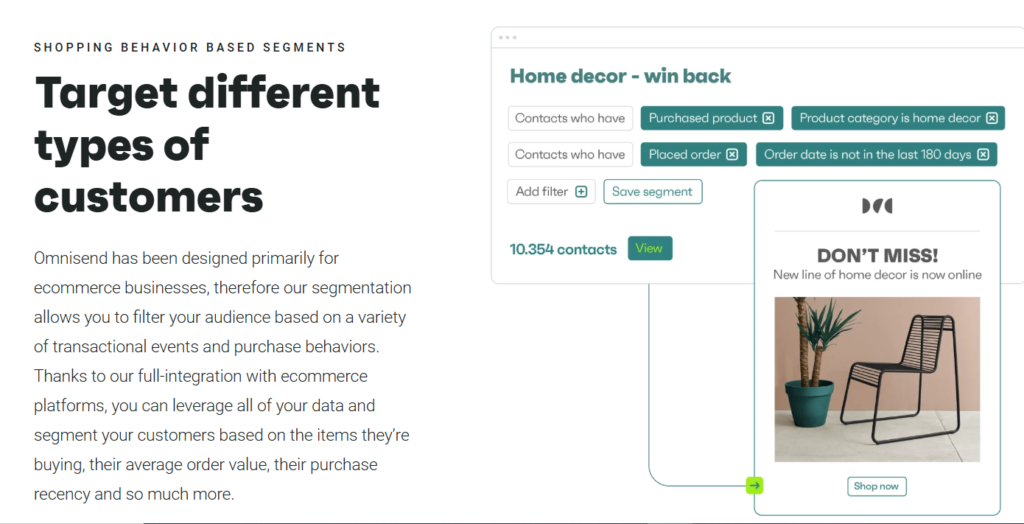
3. E-commerce Integrations Both platforms offer deep integrations with e-commerce platforms, including Shopify, WooCommerce, and BigCommerce. Klaviyo has a reputation for its seamless integration with Shopify, and it leverages this integration to deliver detailed insights on customer behavior, such as lifetime value and engagement.
Omnisend also integrates well with these platforms but doesn’t have quite the same depth of integration as Klaviyo, especially when it comes to analyzing customer purchase behavior. However, Omnisend’s ability to handle both email and SMS through one platform provides a distinct advantage for businesses that want to leverage both channels in a single flow.
4. Reporting and Analytics Klaviyo excels in reporting and analytics, providing in-depth reports on revenue generated from email campaigns, customer lifetime value, and engagement. The platform allows for easy A/B testing, making it easier to fine-tune campaigns for optimal performance.
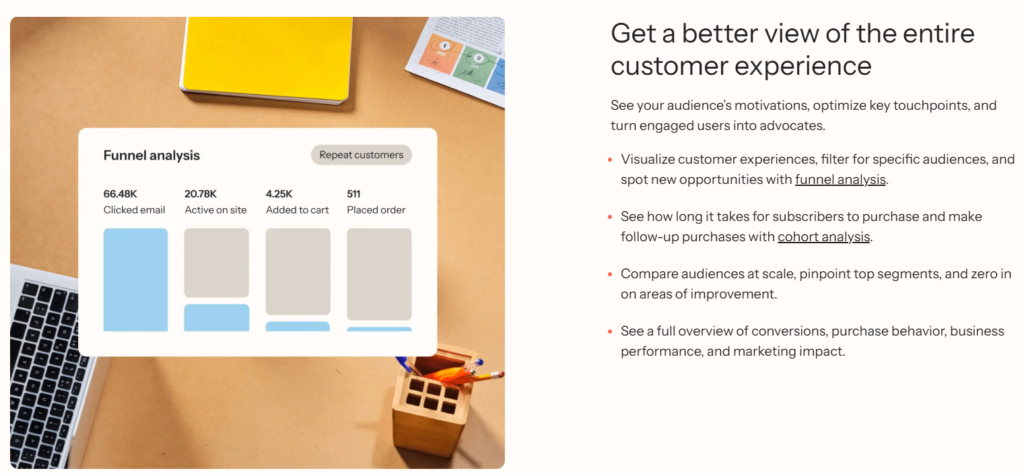
Omnisend also offers reporting tools, but they are more basic in comparison to Klaviyo. Omnisend provides insights into campaign performance, such as open rates, click-through rates, and revenue generated, but lacks the depth of customer insights and predictive analytics that Klaviyo offers.
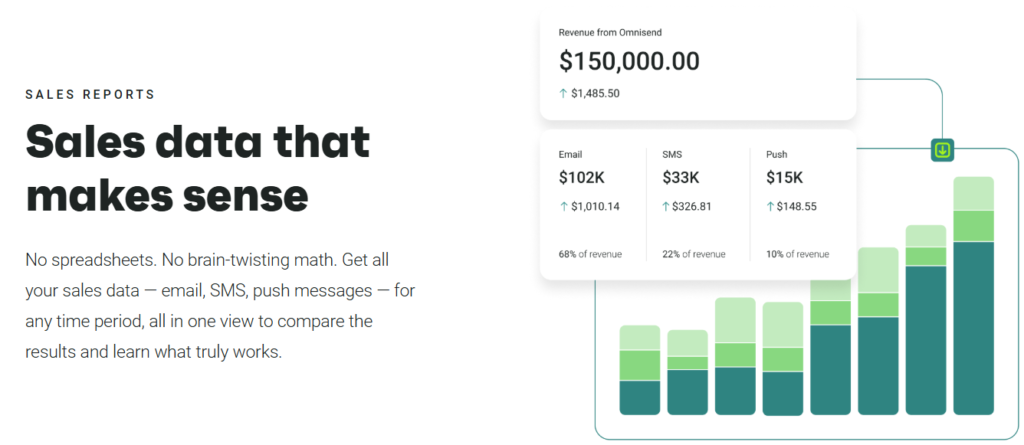
5. Multi-Channel Marketing One key feature where Omnisend takes the lead is its support for multi-channel marketing. With Omnisend, you can run email, SMS, and push notification campaigns all from one platform, making it ideal for businesses that want to engage their audience across multiple channels. Klaviyo, however, primarily focuses on email marketing and lacks built-in SMS capabilities (though you can integrate with third-party SMS services).
Ease of Use
When comparing Klaviyo vs Omnisend, ease of use is a crucial factor for businesses looking to streamline their email marketing efforts. Both platforms are designed with user-friendly interfaces, but they cater to different types of users. Let’s explore how each platform handles usability.
1. User Interface and Dashboard Klaviyo’s interface is clean and intuitive but may feel overwhelming for beginners due to its vast range of features and customization options. The dashboard is highly customizable, allowing you to focus on the most relevant metrics. However, the steep learning curve can be a challenge for those new to email marketing or automation. Once you get the hang of it, Klaviyo’s powerful features become easier to navigate.

Omnisend, on the other hand, is known for its simplicity and ease of use. The platform has a more straightforward layout, which makes it easier for beginners to start using right away. The drag-and-drop email builder and automation workflow designer are intuitive and user-friendly. It’s a great choice for businesses that want to set up campaigns quickly without a lot of prior experience in email marketing.
2. Setup Process Setting up Klaviyo can take a bit more time due to its comprehensive feature set. You need to integrate your e-commerce platform, customize your account, and spend some time learning about its advanced features like segmentation and automation. Klaviyo offers a lot of tutorials and resources, but getting everything up and running may require a little patience.
Omnisend has a quicker setup process. The platform walks you through the setup with an easy-to-follow onboarding process, and you can start building campaigns right after account creation. Its simpler feature set makes the setup process smoother, especially for smaller businesses or those new to email marketing.
3. Email Campaign Builder Both platforms offer visual campaign builders, but Omnisend has an edge when it comes to ease of use. The drag-and-drop builder is very intuitive, and setting up email campaigns feels less complex, making it a good option for those who want to get campaigns live quickly. Omnisend also includes pre-built templates to speed up the process.

Klaviyo’s campaign builder is also powerful, offering advanced customization options. However, because it’s packed with more features, it can be more difficult to navigate for users without previous experience. The platform does have a library of templates, but it’s more focused on customization than ease of use.

4. Automation Workflow Klaviyo excels when it comes to building detailed, customized automation workflows. You can set up complex, multi-step automations based on user behaviors. However, this depth of customization can be overwhelming for users who are new to email marketing automation.
Omnisend, by contrast, offers a simpler approach to automation. It allows users to create email workflows with ease, and you can even combine email campaigns with SMS and push notifications in one workflow. This flexibility is beneficial for users looking to manage their email and SMS marketing in one place, but it may lack the deep customization options available in Klaviyo.
5. Support and Resources Both platforms offer robust customer support, but the experience can vary. Klaviyo provides live chat, email support, and a comprehensive knowledge base. However, due to its feature complexity, you might need more time to find the right resources. There are plenty of video tutorials, but some advanced features may require additional training or help.
Omnisend also offers great support, with live chat, email support, and an extensive help center. Because Omnisend is more straightforward, many users find it easier to get started without requiring as much customer support. Additionally, Omnisend offers pre-built workflow templates, which further enhances the user experience.
Pricing Plans and Value for Money
When comparing Klaviyo vs Omnisend, understanding the pricing plans and the overall value for money is essential for businesses trying to get the most out of their marketing budget. Both platforms offer flexible pricing, but there are key differences in how they charge and what value you get at each price point.
1. Klaviyo Pricing Klaviyo’s pricing is based on the number of contacts you have in your account, which means that as your list grows, your monthly fee will increase. The platform offers a free tier for businesses with fewer than 250 contacts, which includes up to 500 email sends per month. Once you surpass 250 contacts, Klaviyo’s pricing starts at around $20 per month for up to 500 contacts. As your list grows, the price increases accordingly.

For businesses that need more advanced features like SMS marketing or larger email volumes, Klaviyo offers higher pricing tiers. The platform’s pricing can become expensive as you scale, especially if you’re running complex automation and segmentation. However, the advanced features and high level of customization make it worth considering for businesses that need a comprehensive, data-driven email marketing solution.
2. Omnisend Pricing Omnisend also offers a free plan, which allows businesses to send up to 500 emails per month to 250 contacts. Unlike Klaviyo, Omnisend’s free plan includes not only email marketing but also SMS campaigns, which can be a big advantage for businesses wanting to engage customers across multiple channels from the start.
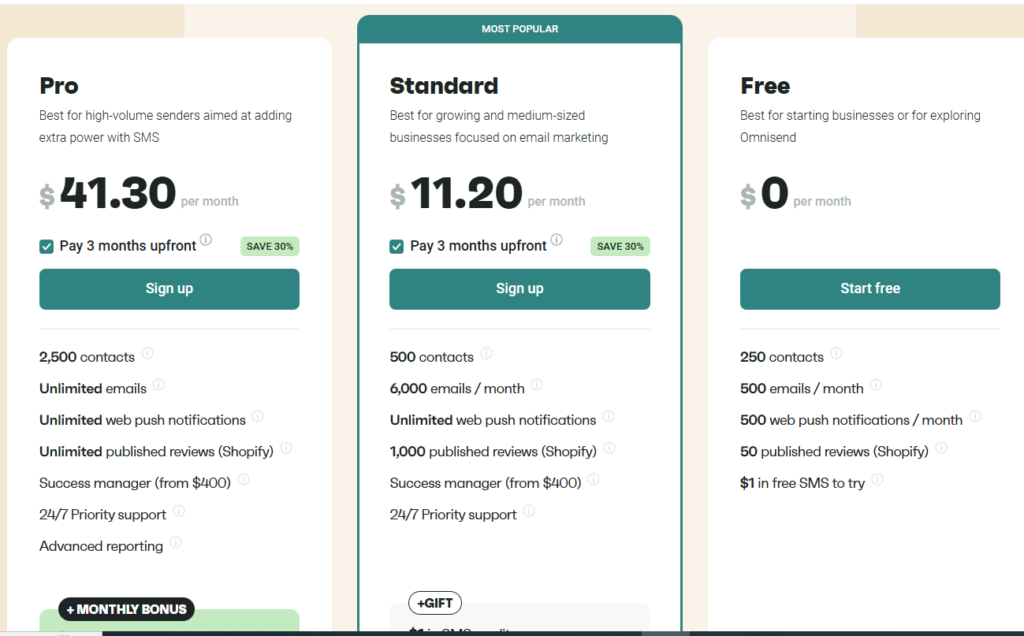
Omnisend’s paid plans start at around $16 per month for the Standard plan, which includes 500 email sends, 60 SMS messages, and advanced features like automation. The pricing structure for Omnisend is based on the number of email subscribers and includes both email and SMS sending limits in the same tier, making it easier to manage budgets across different channels. As you grow your contact list and email volume, Omnisend offers higher-tier plans with more robust features.
3. Comparison of Pricing While both platforms offer free plans, Omnisend tends to be more affordable for businesses that want to run multi-channel campaigns, as its entry-level plans include both email and SMS marketing. Klaviyo, while offering a powerful platform, can become more expensive as your contact list grows, especially for larger businesses that need advanced segmentation and automation features.
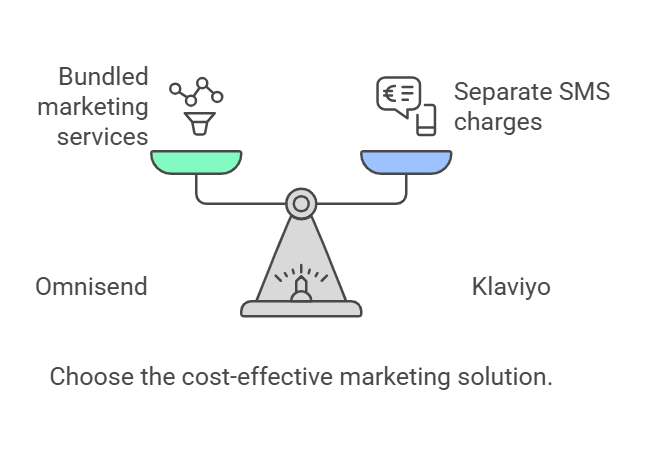
It’s also important to consider the cost of additional services. For example, Klaviyo charges separately for SMS marketing, while Omnisend bundles email and SMS together in one package. This can make Omnisend a better value for businesses looking to run both types of campaigns without worrying about separate charges for each.
4. Value for Money Both platforms offer excellent value for businesses, but the best choice depends on your specific needs:
- If you’re a small business looking for an affordable, all-in-one solution for email and SMS marketing, Omnisend is likely the better value.
- If your business requires more advanced features like predictive analytics, deep integrations with e-commerce platforms, and detailed segmentation, Klaviyo offers more value in terms of its powerful tools—though at a higher price point.
Deliverability and Email Performance
When comparing Klaviyo vs Omnisend, one of the most important aspects to evaluate is email deliverability and overall performance. Both platforms claim to have strong deliverability rates, but how they handle email delivery and performance metrics can impact your campaigns’ effectiveness. Let’s explore how Klaviyo and Omnisend stack up in these key areas.
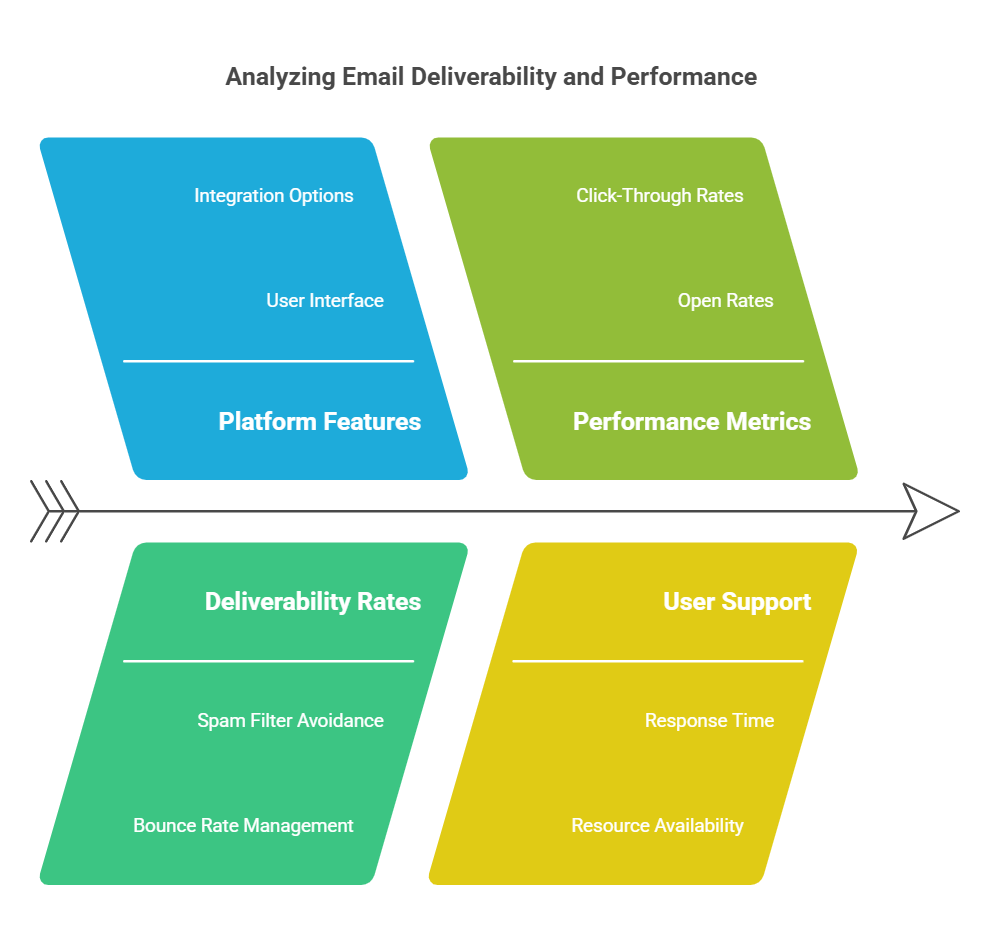
1. Email Deliverability Email deliverability refers to the percentage of emails that successfully reach subscribers’ inboxes, rather than ending up in the spam folder. Both Klaviyo and Omnisend have strong reputations for deliverability, thanks to their infrastructure and compliance with best practices.
Klaviyo boasts a high deliverability rate, typically above 95%. This is largely due to its sophisticated infrastructure, built-in tools for list cleaning, and strong relationships with email service providers. Klaviyo also provides advanced analytics to track email performance, allowing users to see how emails perform and make adjustments to improve future deliverability.
Omnisend also offers high deliverability rates, though some users report slightly lower rates compared to Klaviyo, particularly for businesses with large, unclean email lists. However, Omnisend’s email deliverability is generally above 90%, which is still strong. Omnisend includes automatic list cleaning and deliverability monitoring features, but users may need to pay more attention to list hygiene to maintain high rates.
2. A/B Testing and Optimization Both platforms offer A/B testing features, which are essential for improving email performance. A/B testing lets you experiment with different subject lines, email content, and sending times to see what resonates best with your audience.
Klaviyo excels in A/B testing, allowing users to test multiple variables (like subject lines, content, and call-to-action buttons) and determine the most effective combinations. This makes it a great option for businesses focused on optimizing every email campaign to achieve the highest possible engagement.
Omnisend also provides A/B testing, but with fewer variables compared to Klaviyo. While you can test subject lines and content, Omnisend’s testing capabilities are more limited. However, for many small to medium-sized businesses, Omnisend’s A/B testing is more than enough to run effective campaigns.
3. Reporting and Analytics Both Klaviyo and Omnisend provide robust reporting and analytics tools to track email performance. These tools help businesses understand key metrics like open rates, click-through rates, bounce rates, and revenue generated from campaigns.
Klaviyo offers advanced reporting capabilities that give users deep insights into email performance. You can track individual campaign performance, segment performance, and overall list health. Klaviyo also provides predictive analytics, helping you forecast trends and make data-driven decisions to improve future campaigns.
Omnisend offers solid reporting, but it’s more focused on providing essential metrics like open rates, click-through rates, and revenue. While the data is useful, Omnisend doesn’t offer the same depth of analysis as Klaviyo. However, Omnisend’s reporting is easy to use and is ideal for businesses that want straightforward insights without diving into complex analytics.
4. Bounce Rates and Spam Filters A major factor in deliverability is how each platform handles bounces and spam complaints. Both Klaviyo and Omnisend monitor bounce rates and ensure compliance with email regulations, such as CAN-SPAM.
Klaviyo actively manages bounces and hard bounces, ensuring that emails sent to invalid addresses are flagged and excluded from future campaigns. The platform’s reporting tools allow you to track bounce rates and take corrective actions when necessary.
Omnisend offers similar bounce management tools, but businesses using Omnisend need to be more proactive in managing their email lists. Omnisend will notify users of bounced emails and allow them to clean their lists, but it doesn’t offer the same level of in-depth bounce management that Klaviyo provides.
Customer Support
When comparing Klaviyo vs Omnisend, customer support is a critical factor for businesses that rely on these platforms to manage their email marketing. The quality, responsiveness, and availability of support can make a significant difference, especially if you encounter issues or need assistance with complex campaigns. Let’s take a closer look at the customer support offerings of each platform.
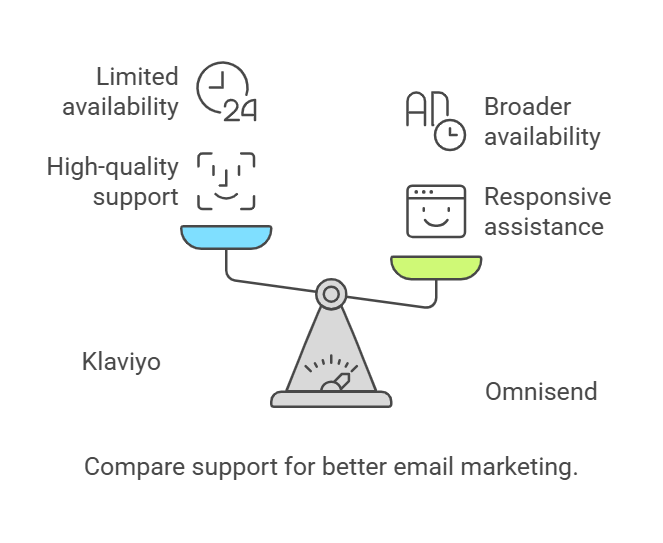
1. Support Channels Both Klaviyo and Omnisend provide several support channels, but they differ in terms of accessibility and response times.
Klaviyo offers support via email, live chat, and a comprehensive help center. The live chat feature is available during business hours, and users can also contact Klaviyo’s support team via email for more in-depth issues. Klaviyo’s help center includes articles, tutorials, and videos that cover a wide range of topics, from setting up your account to optimizing your email campaigns. However, one downside is that the live chat support can sometimes have longer wait times during peak hours, and some users report delays in email responses.
Omnisend provides support through live chat, email, and a detailed knowledge base. The live chat feature is available 24/7, making it more accessible for users in different time zones. Omnisend’s email support is also prompt, with most inquiries being addressed within a few hours. The platform’s knowledge base is extensive and includes helpful guides, FAQs, and troubleshooting tips, making it easy for users to find solutions on their own.
2. Onboarding and Tutorials Both platforms offer solid onboarding support, but the experience differs in terms of depth and ease.
Klaviyo provides an in-depth onboarding process, which includes step-by-step guides to help you set up your account, integrate your e-commerce platform, and create your first email campaign. However, because Klaviyo offers so many advanced features, the learning curve can be steep for new users. Klaviyo offers numerous video tutorials and webinars to help users get familiar with the platform’s capabilities.
Omnisend, in contrast, focuses on simplicity and ease of use, and its onboarding process reflects that. The platform offers an easy-to-follow onboarding wizard that helps users set up their account quickly. Omnisend also provides tutorials that walk users through creating campaigns, building automation workflows, and integrating with e-commerce platforms. The simpler nature of Omnisend means that many users can start using the platform with little to no prior experience in email marketing.
3. Community Support and Resources Community support is another important aspect to consider when comparing Klaviyo vs Omnisend.
Klaviyo has a large and active user community. The Klaviyo Community forum is a great place to ask questions, share experiences, and learn from other users. Additionally, Klaviyo offers webinars, blogs, and an active social media presence to keep users informed about new features and best practices.
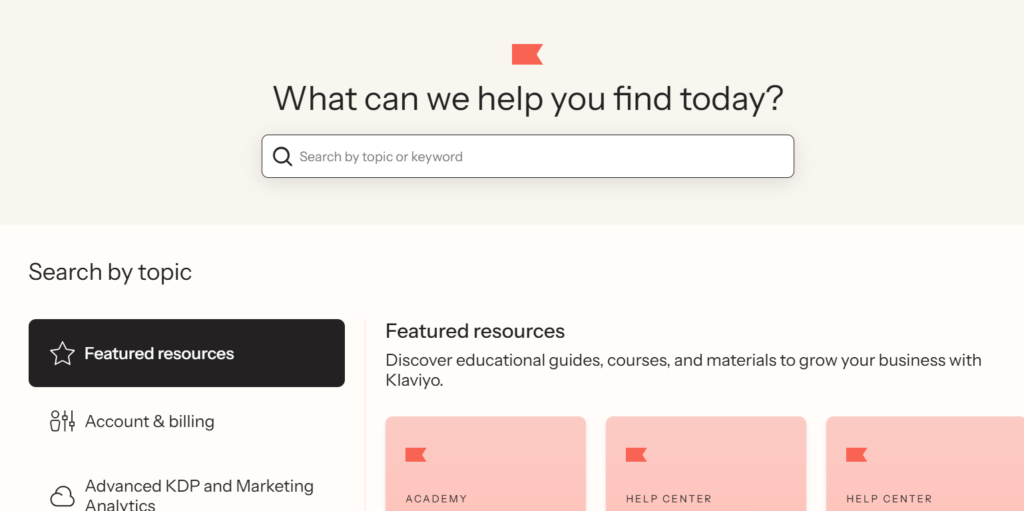
Omnisend also has a user community, though it’s not as large or active as Klaviyo’s. However, Omnisend does offer a range of resources, including webinars, blogs, and a robust help center. Omnisend’s knowledge base is well-organized, making it easy to find solutions to common problems.

4. Response Time and Overall Experience Klaviyo provides quality customer support, but response times can vary, especially during high-volume periods. Some users report slower responses during peak times, but Klaviyo’s support team is generally knowledgeable and provides effective solutions. The platform also offers a variety of educational resources to help users solve issues independently.
Omnisend, on the other hand, is known for its fast and reliable customer support. The 24/7 live chat is a significant advantage for users who need immediate assistance, and the quick response times make Omnisend a good choice for businesses that prioritize efficient support.
Automation and Workflows
When comparing Klaviyo vs Omnisend, automation and workflows are among the most powerful features each platform offers. Both platforms allow businesses to automate their email marketing processes, but they cater to different needs and preferences. Let’s dive into the automation and workflow features of Klaviyo and Omnisend to help you understand how each platform supports your marketing goals.
1. Klaviyo’s Automation and Workflows Klaviyo is known for its advanced automation capabilities, making it an excellent choice for businesses that need highly customized workflows. The platform offers a wide range of automated flows, such as:
- Abandoned cart recovery – Automatically sends emails to users who abandon their shopping cart.
- Welcome series – Engages new subscribers with a series of welcome emails.
- Post-purchase follow-ups – Sends emails encouraging repeat purchases after a customer buys a product.
- Win-back campaigns – Re-engages inactive subscribers with targeted offers.

Klaviyo’s automation tool is highly flexible, allowing users to create complex, multi-step workflows that can be tailored based on user behavior and segmentation. You can set triggers based on customer actions, such as viewing a product or making a purchase. Additionally, Klaviyo’s powerful segmentation capabilities allow you to create extremely granular workflows, ensuring that each customer gets personalized, relevant content.
2. Omnisend’s Automation and Workflows Omnisend, while offering fewer advanced features than Klaviyo, still provides robust automation options that are more than enough for most small to medium-sized businesses. Omnisend’s automation workflows are user-friendly and can be set up with minimal effort. Key automated workflows include:
- Abandoned cart emails – Similar to Klaviyo, Omnisend offers automated cart recovery emails.
- Welcome messages – Automatically sends a series of welcome emails to new subscribers.
- Birthday campaigns – Omnisend allows you to set up automated birthday greetings and special offers.
- Order confirmation emails – Automatically sends purchase confirmations and updates to customers.

Omnisend’s automation system is known for being simple to use, with a drag-and-drop workflow builder that doesn’t require any coding knowledge. It also supports multi-channel workflows, enabling you to automate emails, SMS messages, and push notifications in a single campaign. While the system is less complex than Klaviyo’s, it’s ideal for businesses looking for straightforward and effective automation.
3. Ease of Use and Setup Both Klaviyo and Omnisend offer easy-to-use interfaces for creating and managing automation workflows, but they differ in complexity.
Klaviyo provides a highly customizable experience, which means that while you have more options, there’s also a steeper learning curve. Setting up advanced workflows in Klaviyo can take time, especially for users new to email marketing. However, once you become familiar with the platform, its flexibility and depth of functionality make it an excellent choice for businesses that want full control over their automation.
Omnisend, on the other hand, is designed with simplicity in mind. Its workflow builder is intuitive and allows users to create automated flows quickly without much setup time. The drag-and-drop interface makes it easy for even beginners to get started with automation, but users who need highly advanced, multi-step automation may find Omnisend’s capabilities a bit limiting compared to Klaviyo.
4. Multi-Channel Automation One of the standout features of Omnisend is its multi-channel automation. Unlike Klaviyo, which primarily focuses on email marketing, Omnisend allows you to combine email, SMS, and web push notifications in a single automation workflow. This is particularly useful for businesses that want to engage their audience across different channels and improve customer interaction. For example, you can send a series of abandoned cart emails followed by an SMS reminder, all within one automation flow.

Klaviyo also supports multi-channel workflows, but it is more focused on email marketing. While you can integrate SMS services through third-party integrations, Klaviyo’s native functionality doesn’t include SMS automation, which may require extra setup and additional costs.

5. Reporting and Optimization Both platforms offer reporting tools that help you monitor and optimize your automated workflows. Klaviyo’s reporting is more advanced, providing detailed insights into how your automations are performing. You can track key metrics such as revenue generated from each flow, open rates, click-through rates, and more. Klaviyo also allows you to perform A/B tests within your automation flows, giving you the ability to optimize your campaigns continuously.
Omnisend offers basic reporting for automation workflows, such as open rates, click rates, and revenue generated. While the reporting is useful, it’s not as detailed as Klaviyo’s. However, the simplicity of Omnisend’s reports makes it easy for users to quickly assess the effectiveness of their automations without getting bogged down in data.
Segmentation and Targeting Capabilities
When comparing Klaviyo vs Omnisend, one of the most important factors to consider is their segmentation and targeting capabilities. These features allow businesses to send highly relevant and personalized emails to their subscribers, which can significantly improve engagement and conversion rates. Let’s explore how each platform handles segmentation and targeting.
1. Klaviyo’s Segmentation and Targeting Klaviyo is widely regarded as one of the best platforms when it comes to segmentation and targeting. It offers advanced segmentation tools that enable users to create highly targeted email campaigns based on a variety of factors, including customer behavior, demographics, and purchase history.
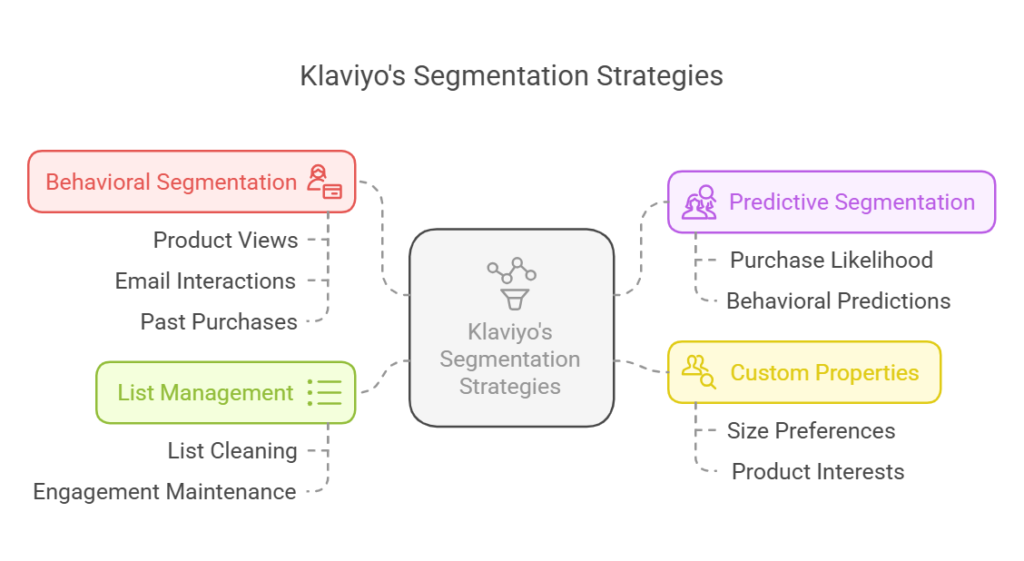
- Behavioral Segmentation: Klaviyo allows you to segment customers based on their actions, such as product views, email opens, clicks, and past purchases. For example, you can create a segment of customers who have purchased a specific product within the last 30 days and send them a follow-up email with related product recommendations.
- Predictive Segmentation: One of Klaviyo’s standout features is its predictive analytics. The platform can automatically create segments based on predicted behavior, such as customers who are likely to make a purchase within the next week. This helps you target customers at the right moment in their buying journey.
- Custom Properties: Klaviyo allows you to create custom properties to further segment your audience. For example, if you sell clothing, you can segment by customer size preferences or specific product interests. This level of granularity makes Klaviyo highly effective for businesses that want to run highly personalized campaigns.
- List Management: Klaviyo also offers tools for cleaning and maintaining your lists, ensuring that you’re targeting the right people and keeping engagement rates high.
2. Omnisend’s Segmentation and Targeting While Omnisend may not offer the same level of depth as Klaviyo in terms of segmentation, it still provides solid tools for targeting customers with relevant campaigns.
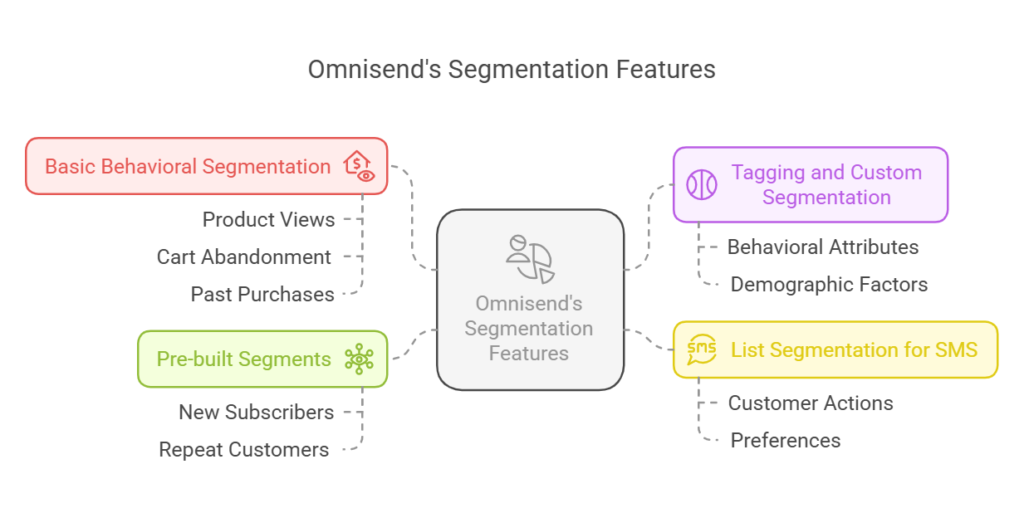
- Basic Behavioral Segmentation: Omnisend allows users to segment customers based on actions such as product views, cart abandonment, and past purchases. For example, you can create a segment of customers who have viewed a product but didn’t make a purchase, and target them with a discount offer or reminder email.
- Tagging and Custom Segmentation: Omnisend lets you tag customers based on various attributes and create custom segments accordingly. This is a helpful feature for targeting specific customer groups based on behavior, demographics, or other factors.
- List Segmentation for SMS: Omnisend excels in SMS marketing, and its segmentation tools extend to SMS as well. This allows you to create targeted SMS campaigns based on customer actions and preferences, which can increase engagement rates across different channels.
- Pre-built Segments: Omnisend offers some pre-built segments, such as “new subscribers” or “repeat customers,” making it easier for businesses to start segmentation quickly without needing to build custom groups from scratch.
3. Ease of Use and Flexibility Klaviyo offers more flexibility and customization options when it comes to segmentation. The platform’s deep integrations with e-commerce stores and powerful analytics allow for highly specific targeting, but it also requires a steeper learning curve. Users who are comfortable with data and need advanced segmentation will find Klaviyo’s tools invaluable.
Omnisend, on the other hand, is easier to use and offers a simpler approach to segmentation. While it may not have the advanced targeting capabilities of Klaviyo, it is still a great choice for businesses that want to quickly create segmented lists and target customers with relevant offers. Its user-friendly interface and pre-built segments make it accessible to beginners and businesses with less technical expertise.
4. Multi-Channel Targeting Both Klaviyo and Omnisend support multi-channel marketing, but Omnisend shines in this area. Omnisend’s segmentation extends across email, SMS, and push notifications, allowing businesses to create multi-channel campaigns for different segments. For example, you can send an email to a segment of cart abandoners and follow it up with an SMS reminder.
Klaviyo also supports multi-channel marketing through integrations with third-party SMS services, but its native segmentation tools are more focused on email marketing. If you’re looking for integrated multi-channel targeting directly within the platform, Omnisend may offer a more seamless experience.
Integrations with Other Tools
When comparing Klaviyo vs Omnisend, integrations with other tools and platforms are key factors to consider. Both platforms offer a wide range of integrations that allow you to connect your email marketing efforts with your e-commerce store, CRM, and other essential tools. Let’s take a closer look at the integrations offered by each platform.
1. Klaviyo Integrations Klaviyo is well-known for its deep and seamless integrations with a variety of platforms, especially e-commerce tools. This makes it an excellent choice for businesses that want to connect their email marketing directly with their online store and other key systems. Some key integrations include:
- E-commerce Platforms: Klaviyo integrates effortlessly with popular e-commerce platforms like Shopify, BigCommerce, WooCommerce, and Magento. This integration allows for the automatic syncing of customer data, such as purchase history, browsing behavior, and cart activity, enabling you to create highly targeted email campaigns based on real-time customer actions.
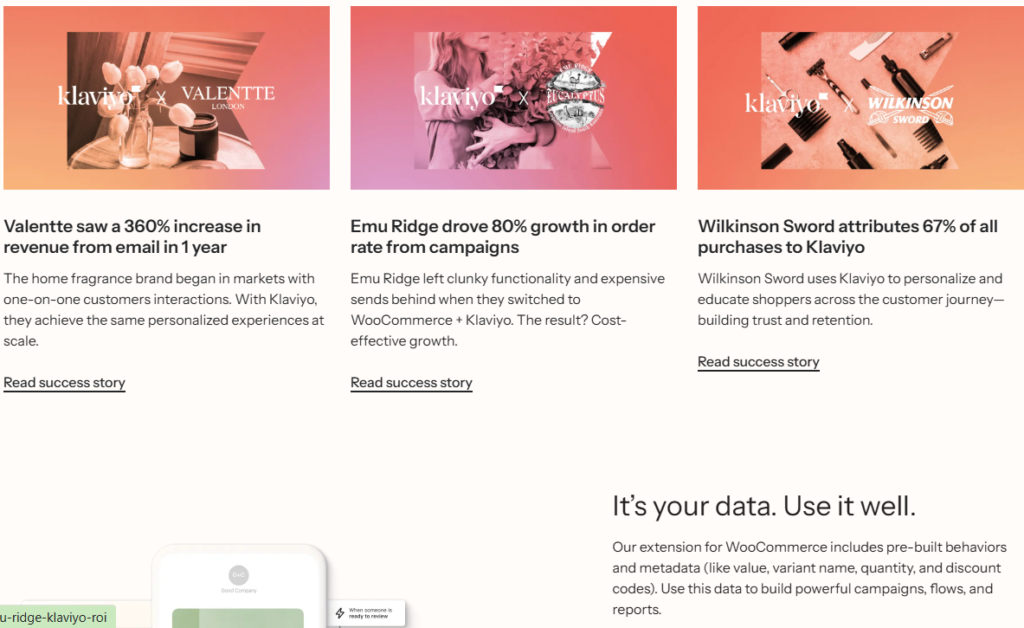
- CRM and Marketing Tools: Klaviyo also integrates with CRM platforms like Salesforce, HubSpot, and Zapier, enabling businesses to sync customer data and automate workflows across platforms. With Zapier, you can connect Klaviyo to hundreds of other apps, streamlining your operations and ensuring that all your tools work together.
- SMS and Push Notifications: Klaviyo allows SMS marketing through third-party integrations like Postscript or Attentive. However, unlike Omnisend, Klaviyo doesn’t have built-in SMS marketing as part of its core offering, so additional integrations are required.
- Analytics and Reporting: Klaviyo integrates with Google Analytics, allowing you to combine your email campaign data with website traffic metrics for a more comprehensive view of your marketing performance.
2. Omnisend Integrations Omnisend also offers a wide range of integrations, with a particular focus on providing an all-in-one marketing platform for small to medium-sized businesses. Omnisend integrates seamlessly with e-commerce platforms and other essential marketing tools. Here are some of the key integrations:
- E-commerce Platforms: Omnisend integrates with Shopify, WooCommerce, BigCommerce, and Magento as well. The integration allows you to sync customer data, manage your contact lists, and automate workflows based on customer behavior. Omnisend’s integration is simple and allows you to set up multi-channel campaigns quickly.
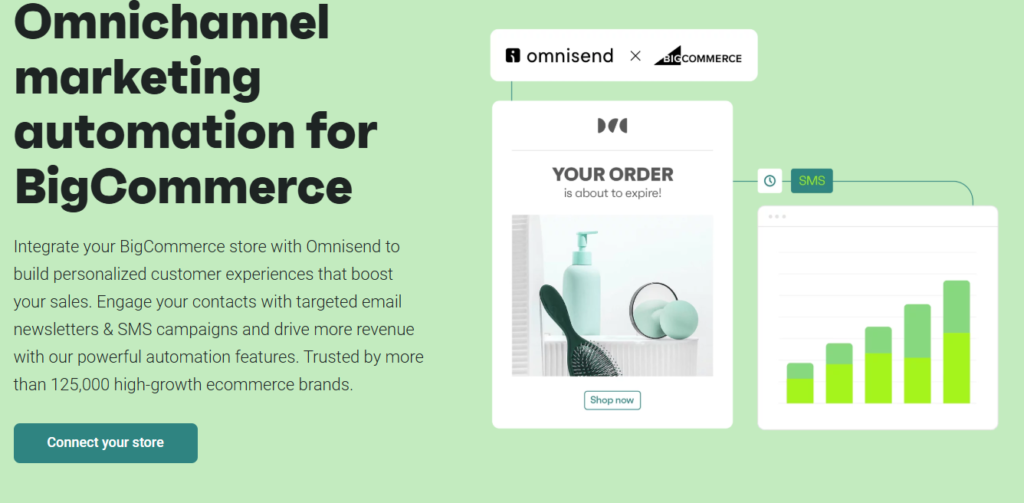
- SMS and Push Notifications: Unlike Klaviyo, Omnisend offers native SMS marketing and push notifications as part of its platform, making it an attractive option for businesses that want to engage customers across multiple channels. You can easily set up SMS and email workflows within the same campaign, giving you the ability to send coordinated messages via email, SMS, and web push.
- CRM and Marketing Tools: Omnisend integrates with Zapier, HubSpot, and Salesforce, allowing businesses to sync customer data and automate workflows. It also connects with popular tools like Google Sheets and Facebook Ads, making it easy to import/export data and run targeted ad campaigns.
- Analytics and Reporting: Omnisend integrates with Google Analytics, providing users with a comprehensive view of their marketing performance across multiple channels. It also offers detailed reporting on email and SMS campaigns, helping businesses make data-driven decisions.
3. Comparison of Integrations Both platforms offer extensive integrations, but there are a few key differences:
- Klaviyo offers more advanced and customizable integrations, especially for businesses that require detailed segmentation and analytics. If your business needs advanced CRM capabilities or you’re using a custom e-commerce platform, Klaviyo’s integrations are more flexible and extensive.
- Omnisend, while not as customizable as Klaviyo in some areas, is easier to set up and offers a more straightforward approach to multi-channel marketing. The fact that Omnisend includes built-in SMS and push notification marketing is a significant advantage, making it a one-stop solution for businesses looking to engage customers across channels without relying on third-party services.
4. API Access Both platforms offer API access for businesses that need to integrate with other tools or develop custom integrations. Klaviyo’s API is robust and well-documented, allowing for extensive customization and integration with almost any system. Omnisend also offers API access, but it’s more limited compared to Klaviyo, which might be a consideration for larger businesses with more complex integration needs.
Conclusion
In this comparison of Klaviyo vs Omnisend, we’ve explored the key features, pricing, automation capabilities, segmentation, integrations, and support offerings of both platforms. Each platform has its strengths, and the best choice for your business will depend on your specific needs and goals.
Klaviyo stands out as the best option for businesses that require advanced segmentation, deep integrations, and powerful analytics. It is particularly suited for e-commerce businesses that need highly customizable workflows and the ability to engage customers based on detailed behavioral data. The platform’s extensive integrations and ability to scale make it ideal for larger businesses or those with more complex marketing needs. However, Klaviyo can be expensive, especially for businesses with large contact lists or complex workflows.
On the other hand, Omnisend is an excellent choice for businesses that are looking for a simpler, more affordable solution for multi-channel marketing. With built-in SMS and push notification capabilities, Omnisend makes it easy to engage customers across different channels without relying on third-party services. It is user-friendly, with a simpler setup process and straightforward automation tools, making it perfect for smaller businesses or those just starting with email marketing. While it may not offer the same depth of segmentation and customization as Klaviyo, Omnisend provides excellent value for money and is well-suited for businesses looking to manage their marketing efforts on a single platform.




